Strategic Information Systems for Business and Enterprise
VerifiedAdded on 2022/10/03
|13
|3570
|251
AI Summary
This article discusses the strengths of manual transaction processing systems, problems avoided with their inclusion, situational pressures in companies, and benefits of distributed computing systems.
Contribute Materials
Your contribution can guide someone’s learning journey. Share your
documents today.
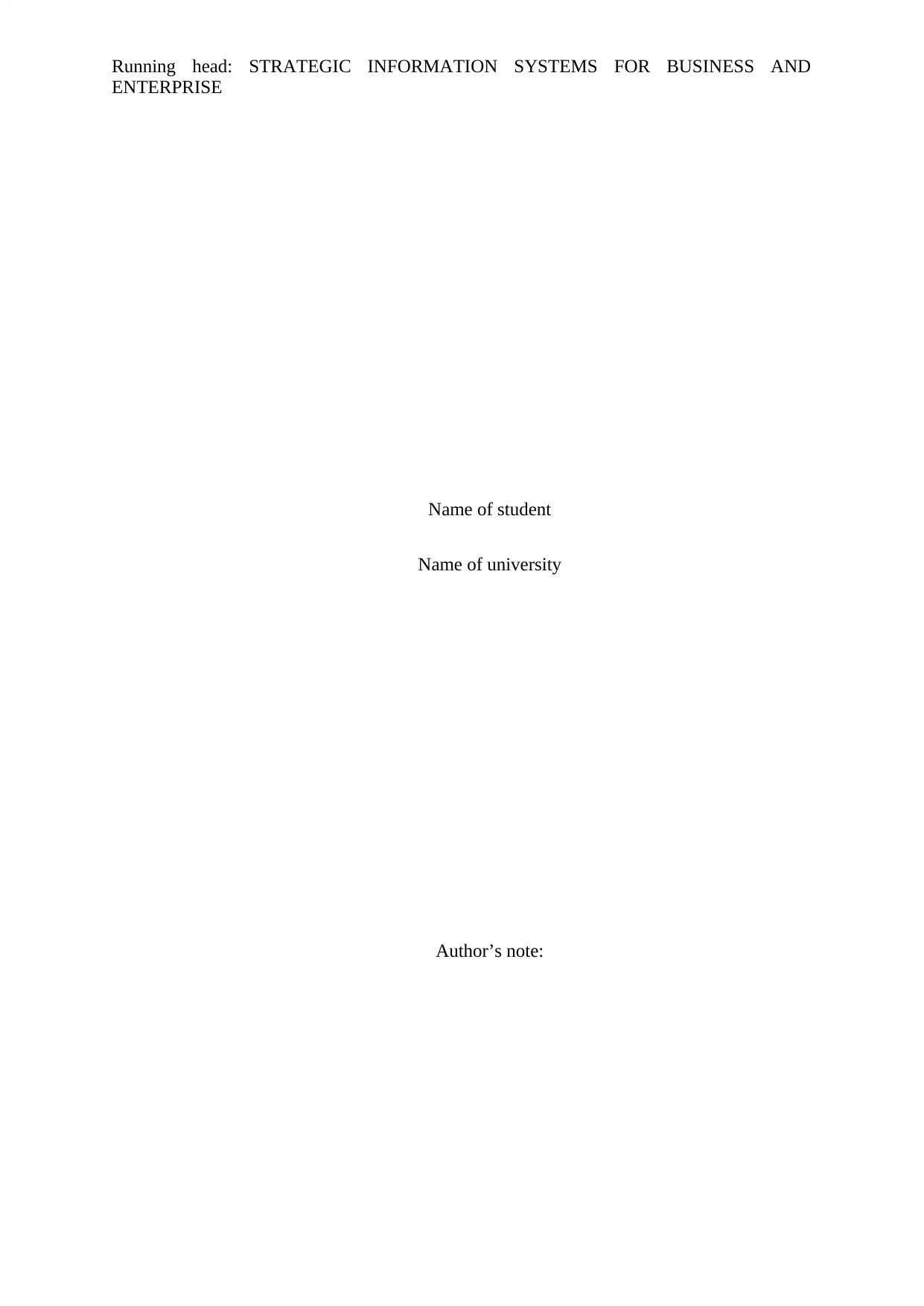
Running head: STRATEGIC INFORMATION SYSTEMS FOR BUSINESS AND
ENTERPRISE
Name of student
Name of university
Author’s note:
ENTERPRISE
Name of student
Name of university
Author’s note:
Secure Best Marks with AI Grader
Need help grading? Try our AI Grader for instant feedback on your assignments.
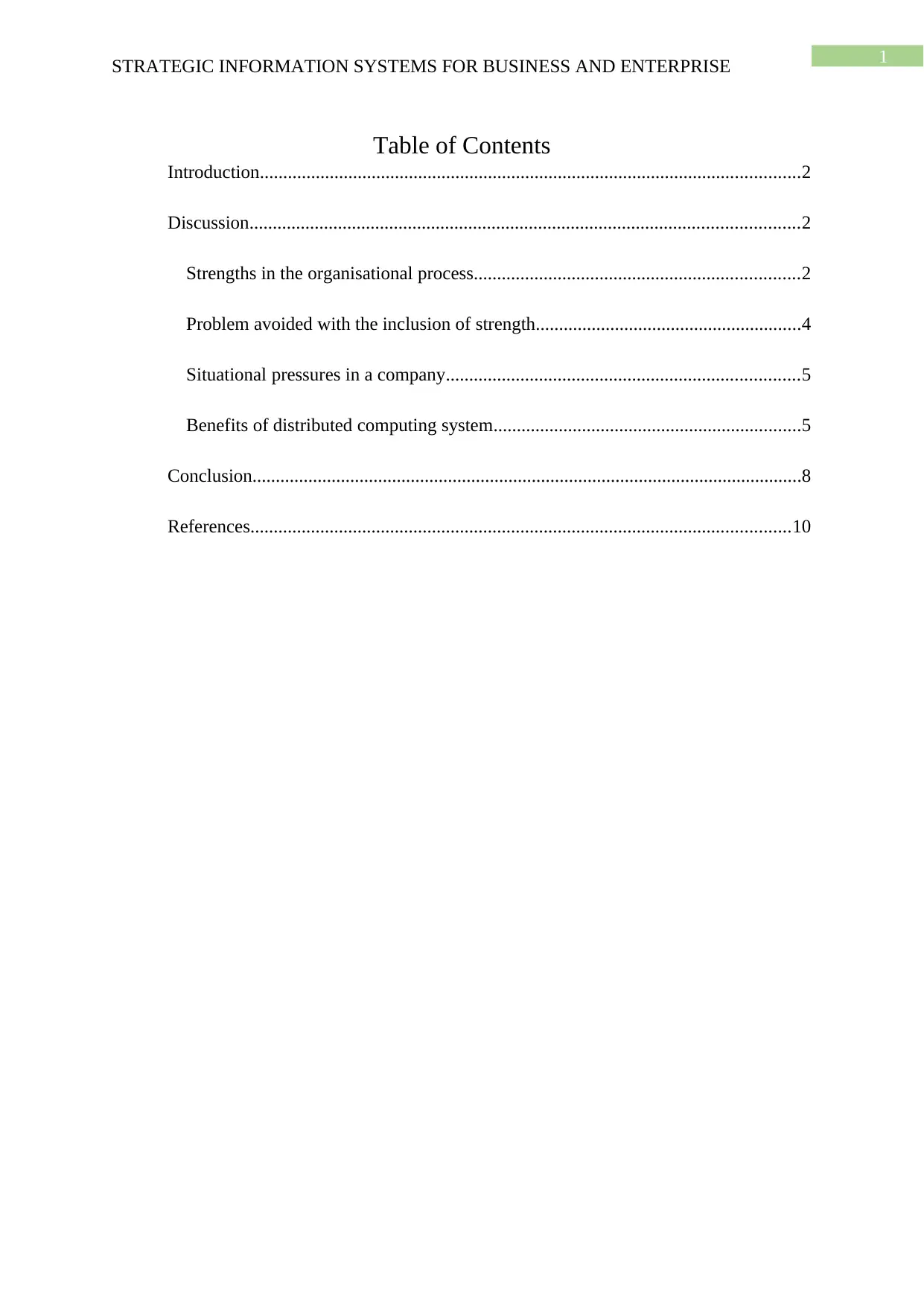
1
STRATEGIC INFORMATION SYSTEMS FOR BUSINESS AND ENTERPRISE
Table of Contents
Introduction....................................................................................................................2
Discussion......................................................................................................................2
Strengths in the organisational process......................................................................2
Problem avoided with the inclusion of strength.........................................................4
Situational pressures in a company............................................................................5
Benefits of distributed computing system..................................................................5
Conclusion......................................................................................................................8
References....................................................................................................................10
STRATEGIC INFORMATION SYSTEMS FOR BUSINESS AND ENTERPRISE
Table of Contents
Introduction....................................................................................................................2
Discussion......................................................................................................................2
Strengths in the organisational process......................................................................2
Problem avoided with the inclusion of strength.........................................................4
Situational pressures in a company............................................................................5
Benefits of distributed computing system..................................................................5
Conclusion......................................................................................................................8
References....................................................................................................................10
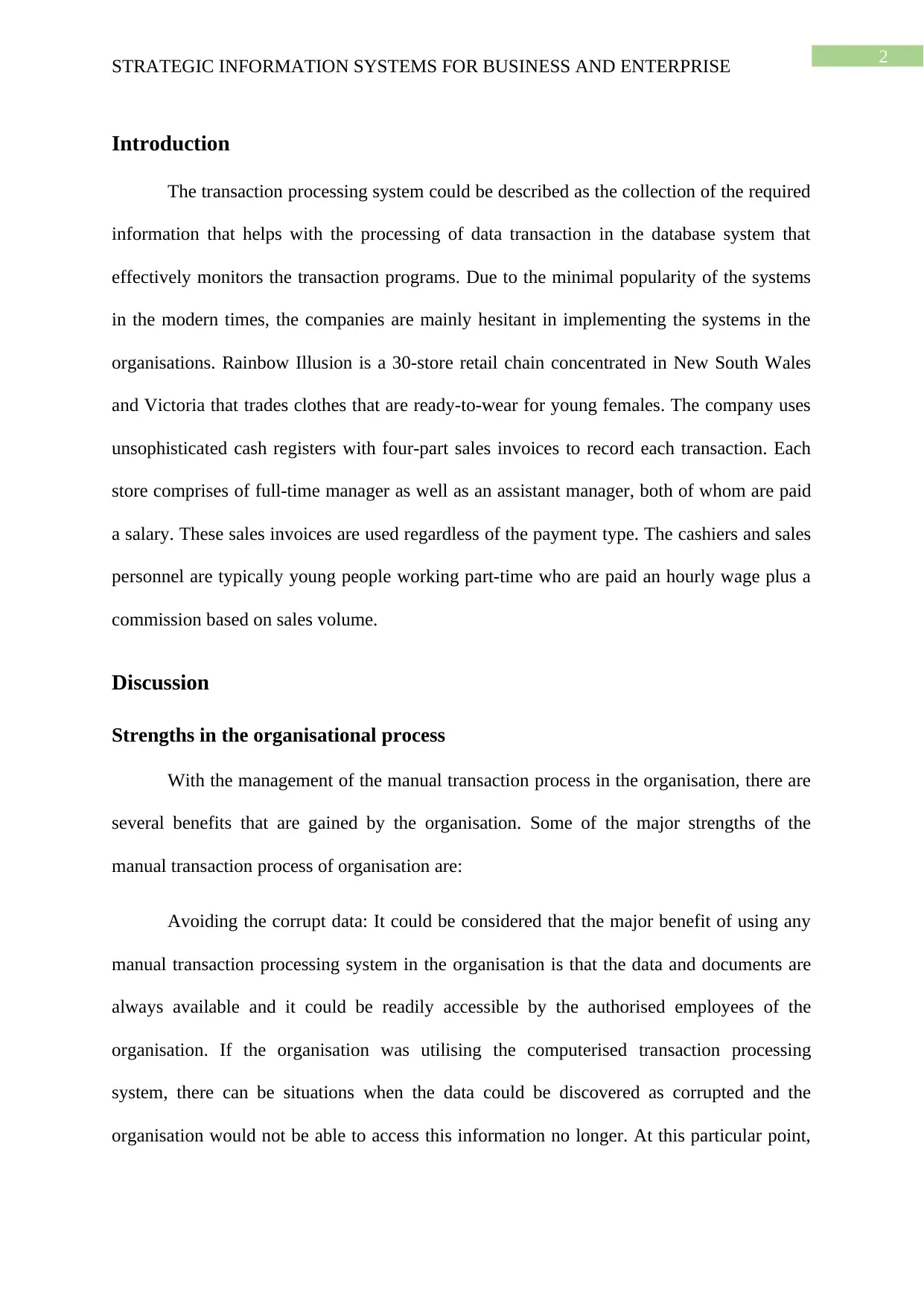
2
STRATEGIC INFORMATION SYSTEMS FOR BUSINESS AND ENTERPRISE
Introduction
The transaction processing system could be described as the collection of the required
information that helps with the processing of data transaction in the database system that
effectively monitors the transaction programs. Due to the minimal popularity of the systems
in the modern times, the companies are mainly hesitant in implementing the systems in the
organisations. Rainbow Illusion is a 30-store retail chain concentrated in New South Wales
and Victoria that trades clothes that are ready-to-wear for young females. The company uses
unsophisticated cash registers with four-part sales invoices to record each transaction. Each
store comprises of full-time manager as well as an assistant manager, both of whom are paid
a salary. These sales invoices are used regardless of the payment type. The cashiers and sales
personnel are typically young people working part-time who are paid an hourly wage plus a
commission based on sales volume.
Discussion
Strengths in the organisational process
With the management of the manual transaction process in the organisation, there are
several benefits that are gained by the organisation. Some of the major strengths of the
manual transaction process of organisation are:
Avoiding the corrupt data: It could be considered that the major benefit of using any
manual transaction processing system in the organisation is that the data and documents are
always available and it could be readily accessible by the authorised employees of the
organisation. If the organisation was utilising the computerised transaction processing
system, there can be situations when the data could be discovered as corrupted and the
organisation would not be able to access this information no longer. At this particular point,
STRATEGIC INFORMATION SYSTEMS FOR BUSINESS AND ENTERPRISE
Introduction
The transaction processing system could be described as the collection of the required
information that helps with the processing of data transaction in the database system that
effectively monitors the transaction programs. Due to the minimal popularity of the systems
in the modern times, the companies are mainly hesitant in implementing the systems in the
organisations. Rainbow Illusion is a 30-store retail chain concentrated in New South Wales
and Victoria that trades clothes that are ready-to-wear for young females. The company uses
unsophisticated cash registers with four-part sales invoices to record each transaction. Each
store comprises of full-time manager as well as an assistant manager, both of whom are paid
a salary. These sales invoices are used regardless of the payment type. The cashiers and sales
personnel are typically young people working part-time who are paid an hourly wage plus a
commission based on sales volume.
Discussion
Strengths in the organisational process
With the management of the manual transaction process in the organisation, there are
several benefits that are gained by the organisation. Some of the major strengths of the
manual transaction process of organisation are:
Avoiding the corrupt data: It could be considered that the major benefit of using any
manual transaction processing system in the organisation is that the data and documents are
always available and it could be readily accessible by the authorised employees of the
organisation. If the organisation was utilising the computerised transaction processing
system, there can be situations when the data could be discovered as corrupted and the
organisation would not be able to access this information no longer. At this particular point,
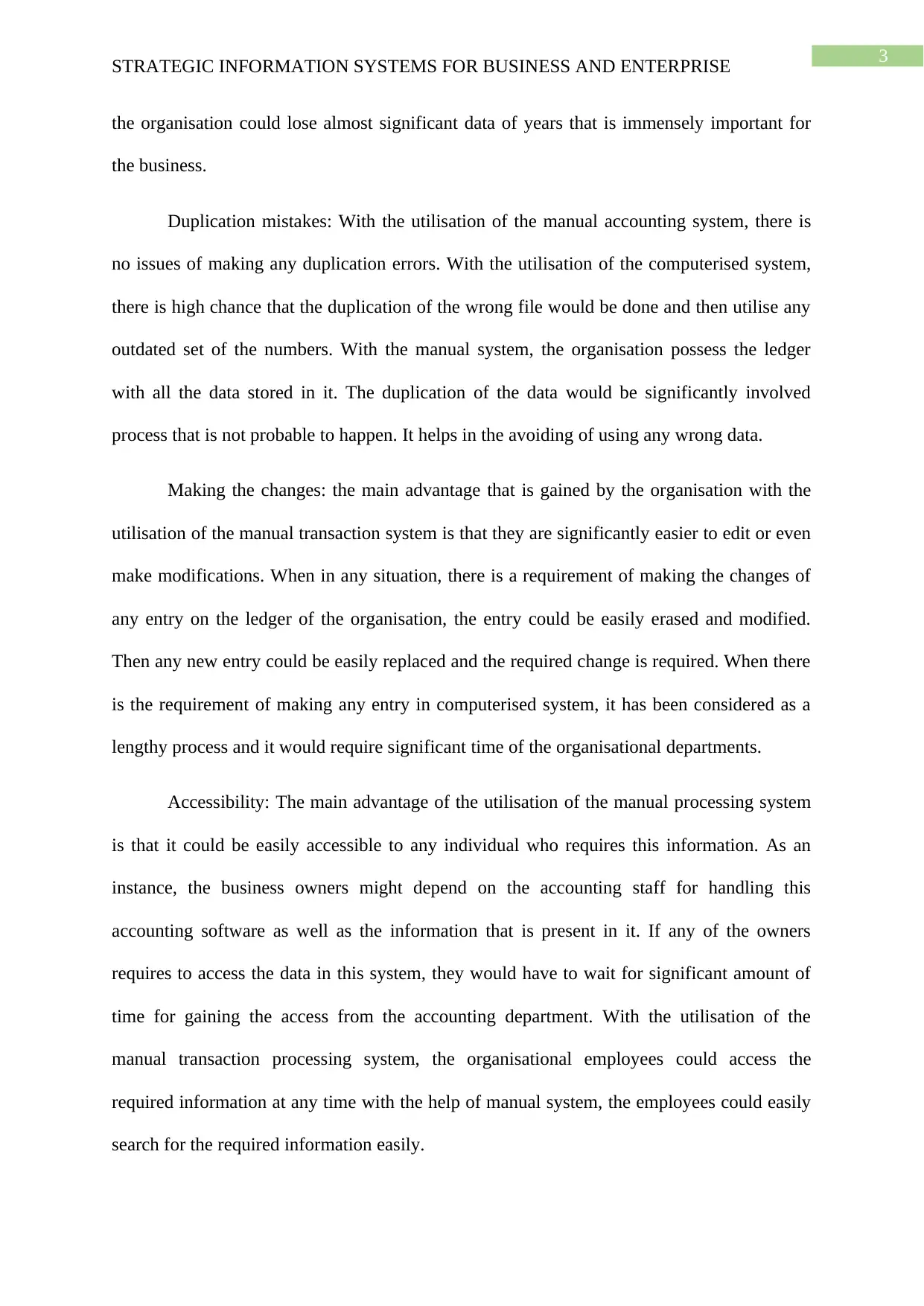
3
STRATEGIC INFORMATION SYSTEMS FOR BUSINESS AND ENTERPRISE
the organisation could lose almost significant data of years that is immensely important for
the business.
Duplication mistakes: With the utilisation of the manual accounting system, there is
no issues of making any duplication errors. With the utilisation of the computerised system,
there is high chance that the duplication of the wrong file would be done and then utilise any
outdated set of the numbers. With the manual system, the organisation possess the ledger
with all the data stored in it. The duplication of the data would be significantly involved
process that is not probable to happen. It helps in the avoiding of using any wrong data.
Making the changes: the main advantage that is gained by the organisation with the
utilisation of the manual transaction system is that they are significantly easier to edit or even
make modifications. When in any situation, there is a requirement of making the changes of
any entry on the ledger of the organisation, the entry could be easily erased and modified.
Then any new entry could be easily replaced and the required change is required. When there
is the requirement of making any entry in computerised system, it has been considered as a
lengthy process and it would require significant time of the organisational departments.
Accessibility: The main advantage of the utilisation of the manual processing system
is that it could be easily accessible to any individual who requires this information. As an
instance, the business owners might depend on the accounting staff for handling this
accounting software as well as the information that is present in it. If any of the owners
requires to access the data in this system, they would have to wait for significant amount of
time for gaining the access from the accounting department. With the utilisation of the
manual transaction processing system, the organisational employees could access the
required information at any time with the help of manual system, the employees could easily
search for the required information easily.
STRATEGIC INFORMATION SYSTEMS FOR BUSINESS AND ENTERPRISE
the organisation could lose almost significant data of years that is immensely important for
the business.
Duplication mistakes: With the utilisation of the manual accounting system, there is
no issues of making any duplication errors. With the utilisation of the computerised system,
there is high chance that the duplication of the wrong file would be done and then utilise any
outdated set of the numbers. With the manual system, the organisation possess the ledger
with all the data stored in it. The duplication of the data would be significantly involved
process that is not probable to happen. It helps in the avoiding of using any wrong data.
Making the changes: the main advantage that is gained by the organisation with the
utilisation of the manual transaction system is that they are significantly easier to edit or even
make modifications. When in any situation, there is a requirement of making the changes of
any entry on the ledger of the organisation, the entry could be easily erased and modified.
Then any new entry could be easily replaced and the required change is required. When there
is the requirement of making any entry in computerised system, it has been considered as a
lengthy process and it would require significant time of the organisational departments.
Accessibility: The main advantage of the utilisation of the manual processing system
is that it could be easily accessible to any individual who requires this information. As an
instance, the business owners might depend on the accounting staff for handling this
accounting software as well as the information that is present in it. If any of the owners
requires to access the data in this system, they would have to wait for significant amount of
time for gaining the access from the accounting department. With the utilisation of the
manual transaction processing system, the organisational employees could access the
required information at any time with the help of manual system, the employees could easily
search for the required information easily.
Secure Best Marks with AI Grader
Need help grading? Try our AI Grader for instant feedback on your assignments.
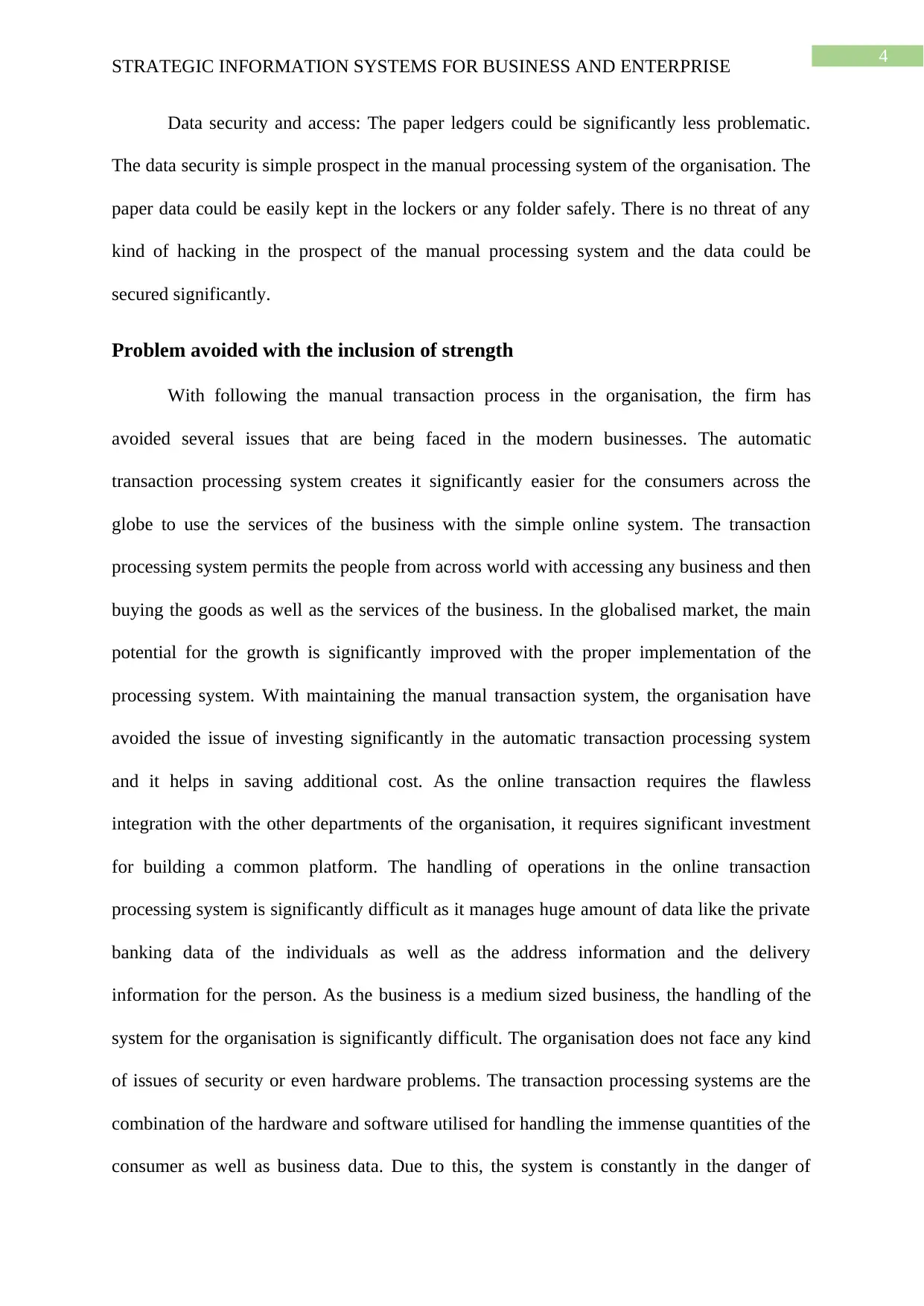
4
STRATEGIC INFORMATION SYSTEMS FOR BUSINESS AND ENTERPRISE
Data security and access: The paper ledgers could be significantly less problematic.
The data security is simple prospect in the manual processing system of the organisation. The
paper data could be easily kept in the lockers or any folder safely. There is no threat of any
kind of hacking in the prospect of the manual processing system and the data could be
secured significantly.
Problem avoided with the inclusion of strength
With following the manual transaction process in the organisation, the firm has
avoided several issues that are being faced in the modern businesses. The automatic
transaction processing system creates it significantly easier for the consumers across the
globe to use the services of the business with the simple online system. The transaction
processing system permits the people from across world with accessing any business and then
buying the goods as well as the services of the business. In the globalised market, the main
potential for the growth is significantly improved with the proper implementation of the
processing system. With maintaining the manual transaction system, the organisation have
avoided the issue of investing significantly in the automatic transaction processing system
and it helps in saving additional cost. As the online transaction requires the flawless
integration with the other departments of the organisation, it requires significant investment
for building a common platform. The handling of operations in the online transaction
processing system is significantly difficult as it manages huge amount of data like the private
banking data of the individuals as well as the address information and the delivery
information for the person. As the business is a medium sized business, the handling of the
system for the organisation is significantly difficult. The organisation does not face any kind
of issues of security or even hardware problems. The transaction processing systems are the
combination of the hardware and software utilised for handling the immense quantities of the
consumer as well as business data. Due to this, the system is constantly in the danger of
STRATEGIC INFORMATION SYSTEMS FOR BUSINESS AND ENTERPRISE
Data security and access: The paper ledgers could be significantly less problematic.
The data security is simple prospect in the manual processing system of the organisation. The
paper data could be easily kept in the lockers or any folder safely. There is no threat of any
kind of hacking in the prospect of the manual processing system and the data could be
secured significantly.
Problem avoided with the inclusion of strength
With following the manual transaction process in the organisation, the firm has
avoided several issues that are being faced in the modern businesses. The automatic
transaction processing system creates it significantly easier for the consumers across the
globe to use the services of the business with the simple online system. The transaction
processing system permits the people from across world with accessing any business and then
buying the goods as well as the services of the business. In the globalised market, the main
potential for the growth is significantly improved with the proper implementation of the
processing system. With maintaining the manual transaction system, the organisation have
avoided the issue of investing significantly in the automatic transaction processing system
and it helps in saving additional cost. As the online transaction requires the flawless
integration with the other departments of the organisation, it requires significant investment
for building a common platform. The handling of operations in the online transaction
processing system is significantly difficult as it manages huge amount of data like the private
banking data of the individuals as well as the address information and the delivery
information for the person. As the business is a medium sized business, the handling of the
system for the organisation is significantly difficult. The organisation does not face any kind
of issues of security or even hardware problems. The transaction processing systems are the
combination of the hardware and software utilised for handling the immense quantities of the
consumer as well as business data. Due to this, the system is constantly in the danger of
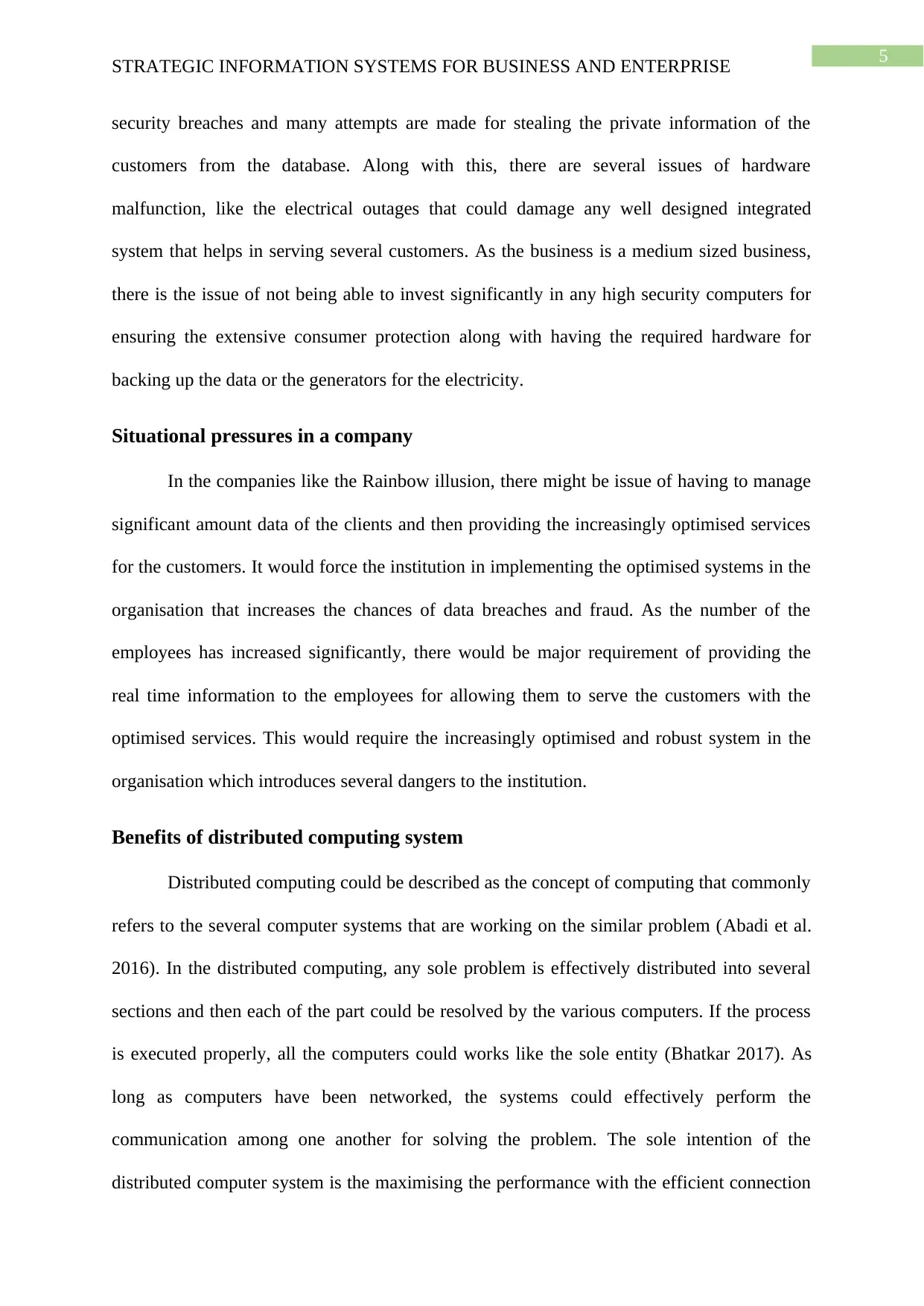
5
STRATEGIC INFORMATION SYSTEMS FOR BUSINESS AND ENTERPRISE
security breaches and many attempts are made for stealing the private information of the
customers from the database. Along with this, there are several issues of hardware
malfunction, like the electrical outages that could damage any well designed integrated
system that helps in serving several customers. As the business is a medium sized business,
there is the issue of not being able to invest significantly in any high security computers for
ensuring the extensive consumer protection along with having the required hardware for
backing up the data or the generators for the electricity.
Situational pressures in a company
In the companies like the Rainbow illusion, there might be issue of having to manage
significant amount data of the clients and then providing the increasingly optimised services
for the customers. It would force the institution in implementing the optimised systems in the
organisation that increases the chances of data breaches and fraud. As the number of the
employees has increased significantly, there would be major requirement of providing the
real time information to the employees for allowing them to serve the customers with the
optimised services. This would require the increasingly optimised and robust system in the
organisation which introduces several dangers to the institution.
Benefits of distributed computing system
Distributed computing could be described as the concept of computing that commonly
refers to the several computer systems that are working on the similar problem (Abadi et al.
2016). In the distributed computing, any sole problem is effectively distributed into several
sections and then each of the part could be resolved by the various computers. If the process
is executed properly, all the computers could works like the sole entity (Bhatkar 2017). As
long as computers have been networked, the systems could effectively perform the
communication among one another for solving the problem. The sole intention of the
distributed computer system is the maximising the performance with the efficient connection
STRATEGIC INFORMATION SYSTEMS FOR BUSINESS AND ENTERPRISE
security breaches and many attempts are made for stealing the private information of the
customers from the database. Along with this, there are several issues of hardware
malfunction, like the electrical outages that could damage any well designed integrated
system that helps in serving several customers. As the business is a medium sized business,
there is the issue of not being able to invest significantly in any high security computers for
ensuring the extensive consumer protection along with having the required hardware for
backing up the data or the generators for the electricity.
Situational pressures in a company
In the companies like the Rainbow illusion, there might be issue of having to manage
significant amount data of the clients and then providing the increasingly optimised services
for the customers. It would force the institution in implementing the optimised systems in the
organisation that increases the chances of data breaches and fraud. As the number of the
employees has increased significantly, there would be major requirement of providing the
real time information to the employees for allowing them to serve the customers with the
optimised services. This would require the increasingly optimised and robust system in the
organisation which introduces several dangers to the institution.
Benefits of distributed computing system
Distributed computing could be described as the concept of computing that commonly
refers to the several computer systems that are working on the similar problem (Abadi et al.
2016). In the distributed computing, any sole problem is effectively distributed into several
sections and then each of the part could be resolved by the various computers. If the process
is executed properly, all the computers could works like the sole entity (Bhatkar 2017). As
long as computers have been networked, the systems could effectively perform the
communication among one another for solving the problem. The sole intention of the
distributed computer system is the maximising the performance with the efficient connection
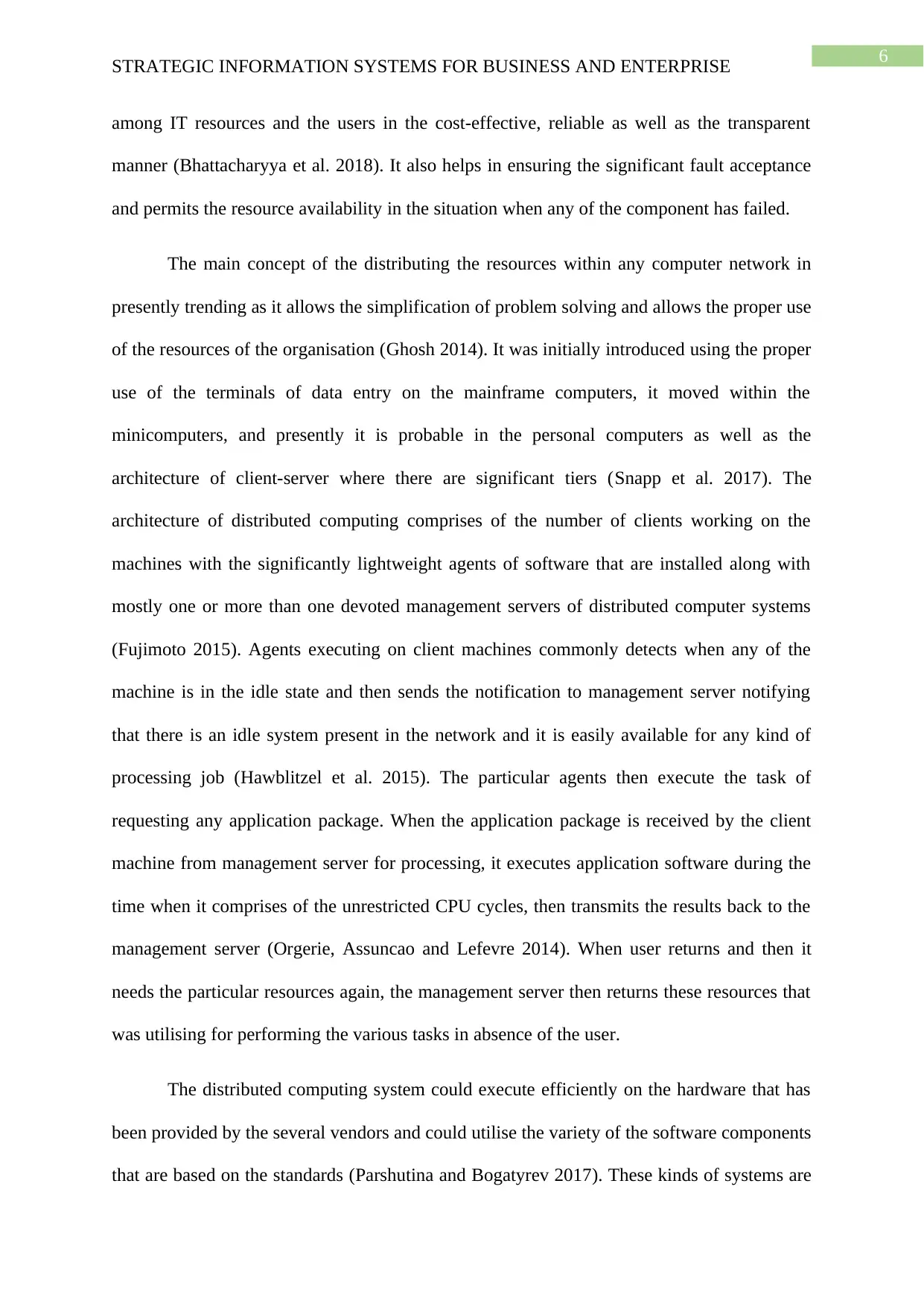
6
STRATEGIC INFORMATION SYSTEMS FOR BUSINESS AND ENTERPRISE
among IT resources and the users in the cost-effective, reliable as well as the transparent
manner (Bhattacharyya et al. 2018). It also helps in ensuring the significant fault acceptance
and permits the resource availability in the situation when any of the component has failed.
The main concept of the distributing the resources within any computer network in
presently trending as it allows the simplification of problem solving and allows the proper use
of the resources of the organisation (Ghosh 2014). It was initially introduced using the proper
use of the terminals of data entry on the mainframe computers, it moved within the
minicomputers, and presently it is probable in the personal computers as well as the
architecture of client-server where there are significant tiers (Snapp et al. 2017). The
architecture of distributed computing comprises of the number of clients working on the
machines with the significantly lightweight agents of software that are installed along with
mostly one or more than one devoted management servers of distributed computer systems
(Fujimoto 2015). Agents executing on client machines commonly detects when any of the
machine is in the idle state and then sends the notification to management server notifying
that there is an idle system present in the network and it is easily available for any kind of
processing job (Hawblitzel et al. 2015). The particular agents then execute the task of
requesting any application package. When the application package is received by the client
machine from management server for processing, it executes application software during the
time when it comprises of the unrestricted CPU cycles, then transmits the results back to the
management server (Orgerie, Assuncao and Lefevre 2014). When user returns and then it
needs the particular resources again, the management server then returns these resources that
was utilising for performing the various tasks in absence of the user.
The distributed computing system could execute efficiently on the hardware that has
been provided by the several vendors and could utilise the variety of the software components
that are based on the standards (Parshutina and Bogatyrev 2017). These kinds of systems are
STRATEGIC INFORMATION SYSTEMS FOR BUSINESS AND ENTERPRISE
among IT resources and the users in the cost-effective, reliable as well as the transparent
manner (Bhattacharyya et al. 2018). It also helps in ensuring the significant fault acceptance
and permits the resource availability in the situation when any of the component has failed.
The main concept of the distributing the resources within any computer network in
presently trending as it allows the simplification of problem solving and allows the proper use
of the resources of the organisation (Ghosh 2014). It was initially introduced using the proper
use of the terminals of data entry on the mainframe computers, it moved within the
minicomputers, and presently it is probable in the personal computers as well as the
architecture of client-server where there are significant tiers (Snapp et al. 2017). The
architecture of distributed computing comprises of the number of clients working on the
machines with the significantly lightweight agents of software that are installed along with
mostly one or more than one devoted management servers of distributed computer systems
(Fujimoto 2015). Agents executing on client machines commonly detects when any of the
machine is in the idle state and then sends the notification to management server notifying
that there is an idle system present in the network and it is easily available for any kind of
processing job (Hawblitzel et al. 2015). The particular agents then execute the task of
requesting any application package. When the application package is received by the client
machine from management server for processing, it executes application software during the
time when it comprises of the unrestricted CPU cycles, then transmits the results back to the
management server (Orgerie, Assuncao and Lefevre 2014). When user returns and then it
needs the particular resources again, the management server then returns these resources that
was utilising for performing the various tasks in absence of the user.
The distributed computing system could execute efficiently on the hardware that has
been provided by the several vendors and could utilise the variety of the software components
that are based on the standards (Parshutina and Bogatyrev 2017). These kinds of systems are
Paraphrase This Document
Need a fresh take? Get an instant paraphrase of this document with our AI Paraphraser
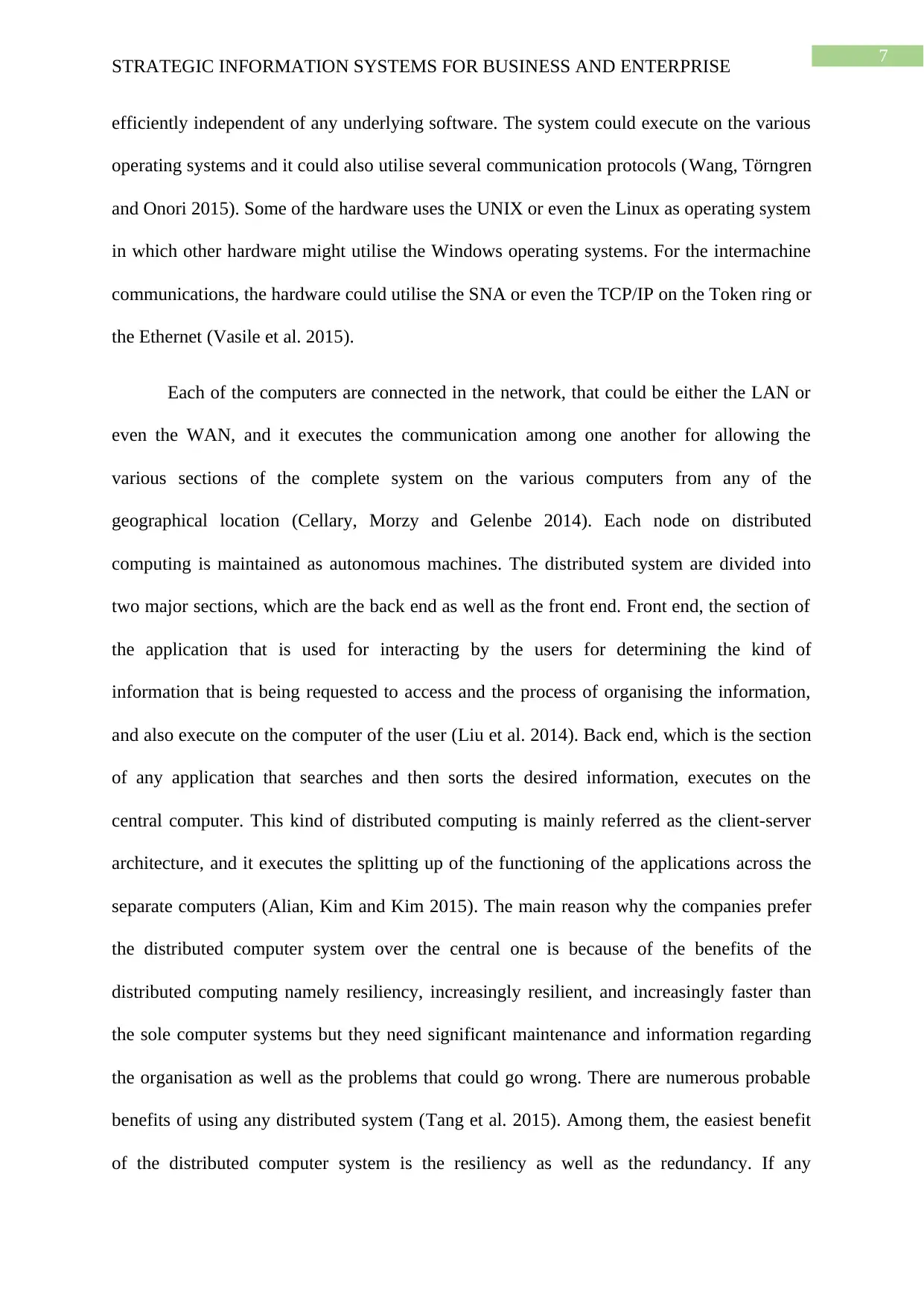
7
STRATEGIC INFORMATION SYSTEMS FOR BUSINESS AND ENTERPRISE
efficiently independent of any underlying software. The system could execute on the various
operating systems and it could also utilise several communication protocols (Wang, Törngren
and Onori 2015). Some of the hardware uses the UNIX or even the Linux as operating system
in which other hardware might utilise the Windows operating systems. For the intermachine
communications, the hardware could utilise the SNA or even the TCP/IP on the Token ring or
the Ethernet (Vasile et al. 2015).
Each of the computers are connected in the network, that could be either the LAN or
even the WAN, and it executes the communication among one another for allowing the
various sections of the complete system on the various computers from any of the
geographical location (Cellary, Morzy and Gelenbe 2014). Each node on distributed
computing is maintained as autonomous machines. The distributed system are divided into
two major sections, which are the back end as well as the front end. Front end, the section of
the application that is used for interacting by the users for determining the kind of
information that is being requested to access and the process of organising the information,
and also execute on the computer of the user (Liu et al. 2014). Back end, which is the section
of any application that searches and then sorts the desired information, executes on the
central computer. This kind of distributed computing is mainly referred as the client-server
architecture, and it executes the splitting up of the functioning of the applications across the
separate computers (Alian, Kim and Kim 2015). The main reason why the companies prefer
the distributed computer system over the central one is because of the benefits of the
distributed computing namely resiliency, increasingly resilient, and increasingly faster than
the sole computer systems but they need significant maintenance and information regarding
the organisation as well as the problems that could go wrong. There are numerous probable
benefits of using any distributed system (Tang et al. 2015). Among them, the easiest benefit
of the distributed computer system is the resiliency as well as the redundancy. If any
STRATEGIC INFORMATION SYSTEMS FOR BUSINESS AND ENTERPRISE
efficiently independent of any underlying software. The system could execute on the various
operating systems and it could also utilise several communication protocols (Wang, Törngren
and Onori 2015). Some of the hardware uses the UNIX or even the Linux as operating system
in which other hardware might utilise the Windows operating systems. For the intermachine
communications, the hardware could utilise the SNA or even the TCP/IP on the Token ring or
the Ethernet (Vasile et al. 2015).
Each of the computers are connected in the network, that could be either the LAN or
even the WAN, and it executes the communication among one another for allowing the
various sections of the complete system on the various computers from any of the
geographical location (Cellary, Morzy and Gelenbe 2014). Each node on distributed
computing is maintained as autonomous machines. The distributed system are divided into
two major sections, which are the back end as well as the front end. Front end, the section of
the application that is used for interacting by the users for determining the kind of
information that is being requested to access and the process of organising the information,
and also execute on the computer of the user (Liu et al. 2014). Back end, which is the section
of any application that searches and then sorts the desired information, executes on the
central computer. This kind of distributed computing is mainly referred as the client-server
architecture, and it executes the splitting up of the functioning of the applications across the
separate computers (Alian, Kim and Kim 2015). The main reason why the companies prefer
the distributed computer system over the central one is because of the benefits of the
distributed computing namely resiliency, increasingly resilient, and increasingly faster than
the sole computer systems but they need significant maintenance and information regarding
the organisation as well as the problems that could go wrong. There are numerous probable
benefits of using any distributed system (Tang et al. 2015). Among them, the easiest benefit
of the distributed computer system is the resiliency as well as the redundancy. If any
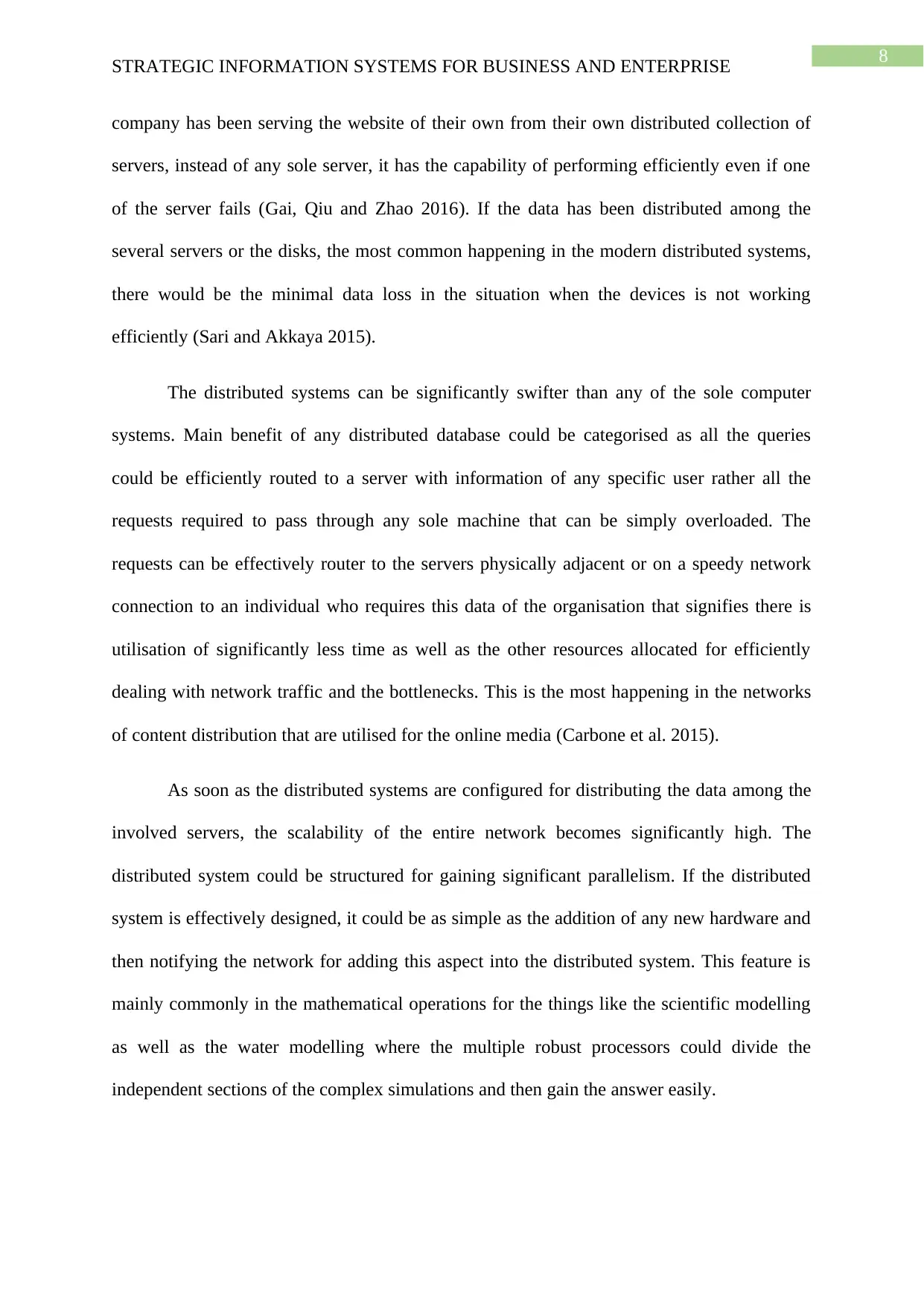
8
STRATEGIC INFORMATION SYSTEMS FOR BUSINESS AND ENTERPRISE
company has been serving the website of their own from their own distributed collection of
servers, instead of any sole server, it has the capability of performing efficiently even if one
of the server fails (Gai, Qiu and Zhao 2016). If the data has been distributed among the
several servers or the disks, the most common happening in the modern distributed systems,
there would be the minimal data loss in the situation when the devices is not working
efficiently (Sari and Akkaya 2015).
The distributed systems can be significantly swifter than any of the sole computer
systems. Main benefit of any distributed database could be categorised as all the queries
could be efficiently routed to a server with information of any specific user rather all the
requests required to pass through any sole machine that can be simply overloaded. The
requests can be effectively router to the servers physically adjacent or on a speedy network
connection to an individual who requires this data of the organisation that signifies there is
utilisation of significantly less time as well as the other resources allocated for efficiently
dealing with network traffic and the bottlenecks. This is the most happening in the networks
of content distribution that are utilised for the online media (Carbone et al. 2015).
As soon as the distributed systems are configured for distributing the data among the
involved servers, the scalability of the entire network becomes significantly high. The
distributed system could be structured for gaining significant parallelism. If the distributed
system is effectively designed, it could be as simple as the addition of any new hardware and
then notifying the network for adding this aspect into the distributed system. This feature is
mainly commonly in the mathematical operations for the things like the scientific modelling
as well as the water modelling where the multiple robust processors could divide the
independent sections of the complex simulations and then gain the answer easily.
STRATEGIC INFORMATION SYSTEMS FOR BUSINESS AND ENTERPRISE
company has been serving the website of their own from their own distributed collection of
servers, instead of any sole server, it has the capability of performing efficiently even if one
of the server fails (Gai, Qiu and Zhao 2016). If the data has been distributed among the
several servers or the disks, the most common happening in the modern distributed systems,
there would be the minimal data loss in the situation when the devices is not working
efficiently (Sari and Akkaya 2015).
The distributed systems can be significantly swifter than any of the sole computer
systems. Main benefit of any distributed database could be categorised as all the queries
could be efficiently routed to a server with information of any specific user rather all the
requests required to pass through any sole machine that can be simply overloaded. The
requests can be effectively router to the servers physically adjacent or on a speedy network
connection to an individual who requires this data of the organisation that signifies there is
utilisation of significantly less time as well as the other resources allocated for efficiently
dealing with network traffic and the bottlenecks. This is the most happening in the networks
of content distribution that are utilised for the online media (Carbone et al. 2015).
As soon as the distributed systems are configured for distributing the data among the
involved servers, the scalability of the entire network becomes significantly high. The
distributed system could be structured for gaining significant parallelism. If the distributed
system is effectively designed, it could be as simple as the addition of any new hardware and
then notifying the network for adding this aspect into the distributed system. This feature is
mainly commonly in the mathematical operations for the things like the scientific modelling
as well as the water modelling where the multiple robust processors could divide the
independent sections of the complex simulations and then gain the answer easily.
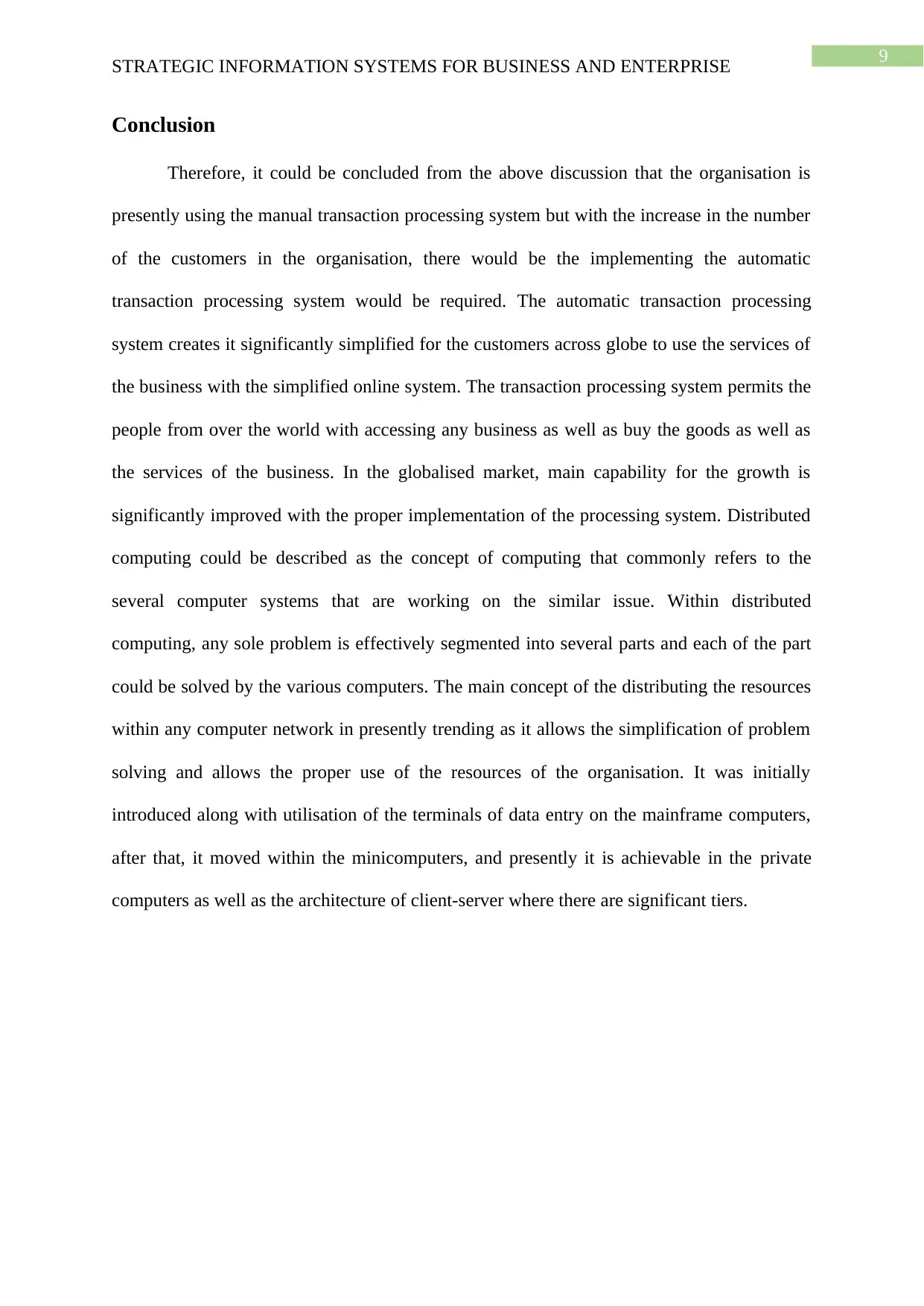
9
STRATEGIC INFORMATION SYSTEMS FOR BUSINESS AND ENTERPRISE
Conclusion
Therefore, it could be concluded from the above discussion that the organisation is
presently using the manual transaction processing system but with the increase in the number
of the customers in the organisation, there would be the implementing the automatic
transaction processing system would be required. The automatic transaction processing
system creates it significantly simplified for the customers across globe to use the services of
the business with the simplified online system. The transaction processing system permits the
people from over the world with accessing any business as well as buy the goods as well as
the services of the business. In the globalised market, main capability for the growth is
significantly improved with the proper implementation of the processing system. Distributed
computing could be described as the concept of computing that commonly refers to the
several computer systems that are working on the similar issue. Within distributed
computing, any sole problem is effectively segmented into several parts and each of the part
could be solved by the various computers. The main concept of the distributing the resources
within any computer network in presently trending as it allows the simplification of problem
solving and allows the proper use of the resources of the organisation. It was initially
introduced along with utilisation of the terminals of data entry on the mainframe computers,
after that, it moved within the minicomputers, and presently it is achievable in the private
computers as well as the architecture of client-server where there are significant tiers.
STRATEGIC INFORMATION SYSTEMS FOR BUSINESS AND ENTERPRISE
Conclusion
Therefore, it could be concluded from the above discussion that the organisation is
presently using the manual transaction processing system but with the increase in the number
of the customers in the organisation, there would be the implementing the automatic
transaction processing system would be required. The automatic transaction processing
system creates it significantly simplified for the customers across globe to use the services of
the business with the simplified online system. The transaction processing system permits the
people from over the world with accessing any business as well as buy the goods as well as
the services of the business. In the globalised market, main capability for the growth is
significantly improved with the proper implementation of the processing system. Distributed
computing could be described as the concept of computing that commonly refers to the
several computer systems that are working on the similar issue. Within distributed
computing, any sole problem is effectively segmented into several parts and each of the part
could be solved by the various computers. The main concept of the distributing the resources
within any computer network in presently trending as it allows the simplification of problem
solving and allows the proper use of the resources of the organisation. It was initially
introduced along with utilisation of the terminals of data entry on the mainframe computers,
after that, it moved within the minicomputers, and presently it is achievable in the private
computers as well as the architecture of client-server where there are significant tiers.
Secure Best Marks with AI Grader
Need help grading? Try our AI Grader for instant feedback on your assignments.
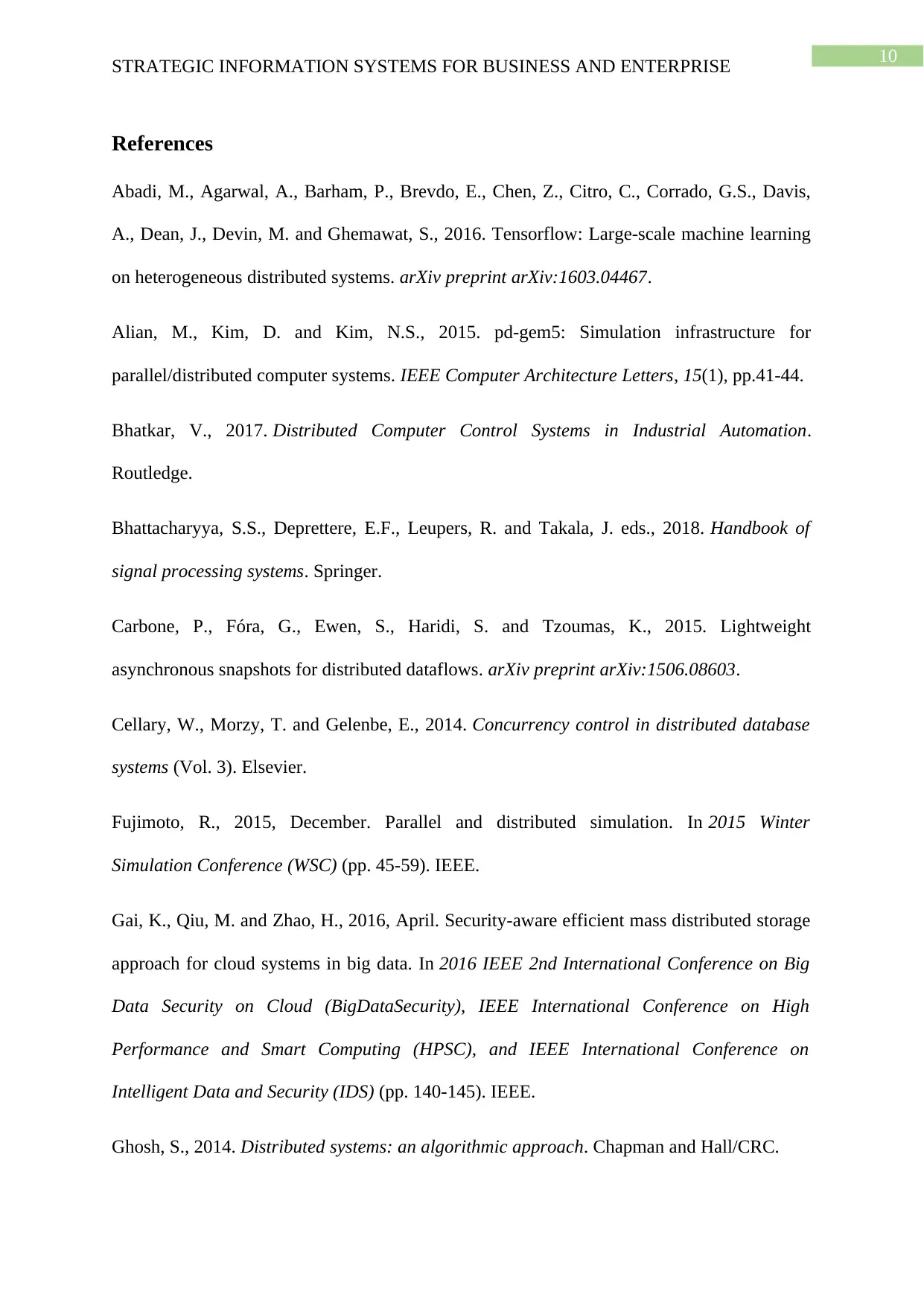
10
STRATEGIC INFORMATION SYSTEMS FOR BUSINESS AND ENTERPRISE
References
Abadi, M., Agarwal, A., Barham, P., Brevdo, E., Chen, Z., Citro, C., Corrado, G.S., Davis,
A., Dean, J., Devin, M. and Ghemawat, S., 2016. Tensorflow: Large-scale machine learning
on heterogeneous distributed systems. arXiv preprint arXiv:1603.04467.
Alian, M., Kim, D. and Kim, N.S., 2015. pd-gem5: Simulation infrastructure for
parallel/distributed computer systems. IEEE Computer Architecture Letters, 15(1), pp.41-44.
Bhatkar, V., 2017. Distributed Computer Control Systems in Industrial Automation.
Routledge.
Bhattacharyya, S.S., Deprettere, E.F., Leupers, R. and Takala, J. eds., 2018. Handbook of
signal processing systems. Springer.
Carbone, P., Fóra, G., Ewen, S., Haridi, S. and Tzoumas, K., 2015. Lightweight
asynchronous snapshots for distributed dataflows. arXiv preprint arXiv:1506.08603.
Cellary, W., Morzy, T. and Gelenbe, E., 2014. Concurrency control in distributed database
systems (Vol. 3). Elsevier.
Fujimoto, R., 2015, December. Parallel and distributed simulation. In 2015 Winter
Simulation Conference (WSC) (pp. 45-59). IEEE.
Gai, K., Qiu, M. and Zhao, H., 2016, April. Security-aware efficient mass distributed storage
approach for cloud systems in big data. In 2016 IEEE 2nd International Conference on Big
Data Security on Cloud (BigDataSecurity), IEEE International Conference on High
Performance and Smart Computing (HPSC), and IEEE International Conference on
Intelligent Data and Security (IDS) (pp. 140-145). IEEE.
Ghosh, S., 2014. Distributed systems: an algorithmic approach. Chapman and Hall/CRC.
STRATEGIC INFORMATION SYSTEMS FOR BUSINESS AND ENTERPRISE
References
Abadi, M., Agarwal, A., Barham, P., Brevdo, E., Chen, Z., Citro, C., Corrado, G.S., Davis,
A., Dean, J., Devin, M. and Ghemawat, S., 2016. Tensorflow: Large-scale machine learning
on heterogeneous distributed systems. arXiv preprint arXiv:1603.04467.
Alian, M., Kim, D. and Kim, N.S., 2015. pd-gem5: Simulation infrastructure for
parallel/distributed computer systems. IEEE Computer Architecture Letters, 15(1), pp.41-44.
Bhatkar, V., 2017. Distributed Computer Control Systems in Industrial Automation.
Routledge.
Bhattacharyya, S.S., Deprettere, E.F., Leupers, R. and Takala, J. eds., 2018. Handbook of
signal processing systems. Springer.
Carbone, P., Fóra, G., Ewen, S., Haridi, S. and Tzoumas, K., 2015. Lightweight
asynchronous snapshots for distributed dataflows. arXiv preprint arXiv:1506.08603.
Cellary, W., Morzy, T. and Gelenbe, E., 2014. Concurrency control in distributed database
systems (Vol. 3). Elsevier.
Fujimoto, R., 2015, December. Parallel and distributed simulation. In 2015 Winter
Simulation Conference (WSC) (pp. 45-59). IEEE.
Gai, K., Qiu, M. and Zhao, H., 2016, April. Security-aware efficient mass distributed storage
approach for cloud systems in big data. In 2016 IEEE 2nd International Conference on Big
Data Security on Cloud (BigDataSecurity), IEEE International Conference on High
Performance and Smart Computing (HPSC), and IEEE International Conference on
Intelligent Data and Security (IDS) (pp. 140-145). IEEE.
Ghosh, S., 2014. Distributed systems: an algorithmic approach. Chapman and Hall/CRC.
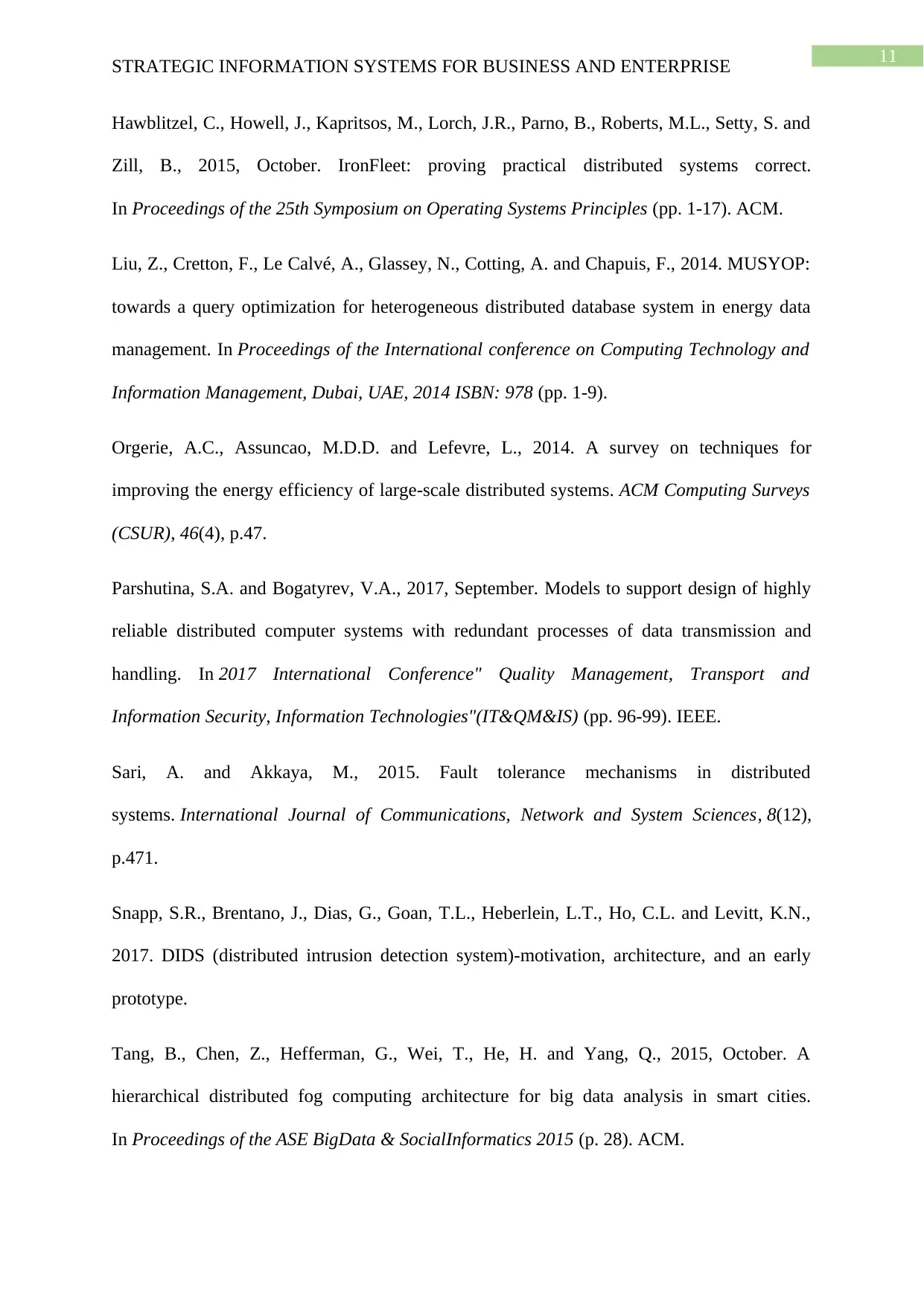
11
STRATEGIC INFORMATION SYSTEMS FOR BUSINESS AND ENTERPRISE
Hawblitzel, C., Howell, J., Kapritsos, M., Lorch, J.R., Parno, B., Roberts, M.L., Setty, S. and
Zill, B., 2015, October. IronFleet: proving practical distributed systems correct.
In Proceedings of the 25th Symposium on Operating Systems Principles (pp. 1-17). ACM.
Liu, Z., Cretton, F., Le Calvé, A., Glassey, N., Cotting, A. and Chapuis, F., 2014. MUSYOP:
towards a query optimization for heterogeneous distributed database system in energy data
management. In Proceedings of the International conference on Computing Technology and
Information Management, Dubai, UAE, 2014 ISBN: 978 (pp. 1-9).
Orgerie, A.C., Assuncao, M.D.D. and Lefevre, L., 2014. A survey on techniques for
improving the energy efficiency of large-scale distributed systems. ACM Computing Surveys
(CSUR), 46(4), p.47.
Parshutina, S.A. and Bogatyrev, V.A., 2017, September. Models to support design of highly
reliable distributed computer systems with redundant processes of data transmission and
handling. In 2017 International Conference" Quality Management, Transport and
Information Security, Information Technologies"(IT&QM&IS) (pp. 96-99). IEEE.
Sari, A. and Akkaya, M., 2015. Fault tolerance mechanisms in distributed
systems. International Journal of Communications, Network and System Sciences, 8(12),
p.471.
Snapp, S.R., Brentano, J., Dias, G., Goan, T.L., Heberlein, L.T., Ho, C.L. and Levitt, K.N.,
2017. DIDS (distributed intrusion detection system)-motivation, architecture, and an early
prototype.
Tang, B., Chen, Z., Hefferman, G., Wei, T., He, H. and Yang, Q., 2015, October. A
hierarchical distributed fog computing architecture for big data analysis in smart cities.
In Proceedings of the ASE BigData & SocialInformatics 2015 (p. 28). ACM.
STRATEGIC INFORMATION SYSTEMS FOR BUSINESS AND ENTERPRISE
Hawblitzel, C., Howell, J., Kapritsos, M., Lorch, J.R., Parno, B., Roberts, M.L., Setty, S. and
Zill, B., 2015, October. IronFleet: proving practical distributed systems correct.
In Proceedings of the 25th Symposium on Operating Systems Principles (pp. 1-17). ACM.
Liu, Z., Cretton, F., Le Calvé, A., Glassey, N., Cotting, A. and Chapuis, F., 2014. MUSYOP:
towards a query optimization for heterogeneous distributed database system in energy data
management. In Proceedings of the International conference on Computing Technology and
Information Management, Dubai, UAE, 2014 ISBN: 978 (pp. 1-9).
Orgerie, A.C., Assuncao, M.D.D. and Lefevre, L., 2014. A survey on techniques for
improving the energy efficiency of large-scale distributed systems. ACM Computing Surveys
(CSUR), 46(4), p.47.
Parshutina, S.A. and Bogatyrev, V.A., 2017, September. Models to support design of highly
reliable distributed computer systems with redundant processes of data transmission and
handling. In 2017 International Conference" Quality Management, Transport and
Information Security, Information Technologies"(IT&QM&IS) (pp. 96-99). IEEE.
Sari, A. and Akkaya, M., 2015. Fault tolerance mechanisms in distributed
systems. International Journal of Communications, Network and System Sciences, 8(12),
p.471.
Snapp, S.R., Brentano, J., Dias, G., Goan, T.L., Heberlein, L.T., Ho, C.L. and Levitt, K.N.,
2017. DIDS (distributed intrusion detection system)-motivation, architecture, and an early
prototype.
Tang, B., Chen, Z., Hefferman, G., Wei, T., He, H. and Yang, Q., 2015, October. A
hierarchical distributed fog computing architecture for big data analysis in smart cities.
In Proceedings of the ASE BigData & SocialInformatics 2015 (p. 28). ACM.
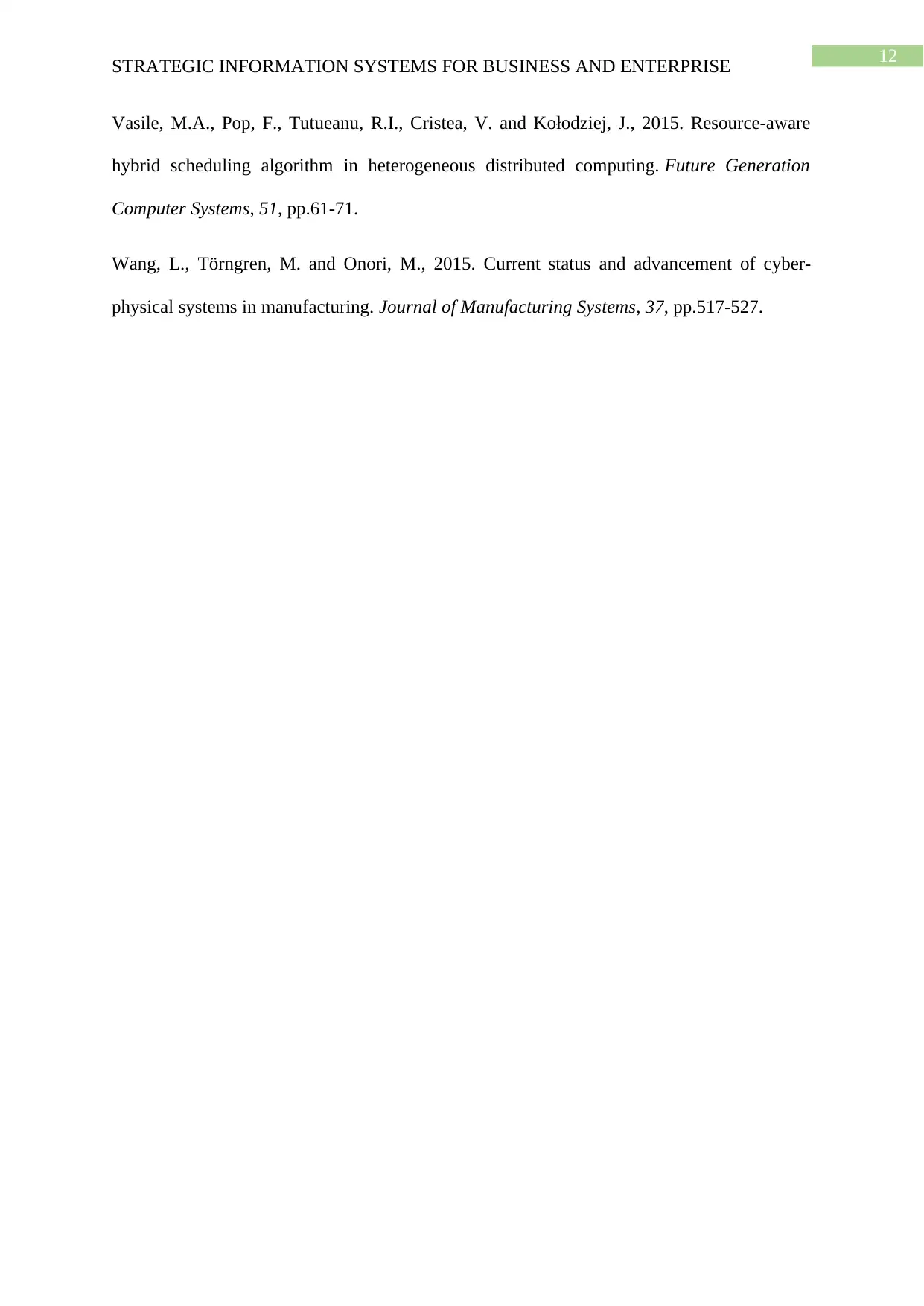
12
STRATEGIC INFORMATION SYSTEMS FOR BUSINESS AND ENTERPRISE
Vasile, M.A., Pop, F., Tutueanu, R.I., Cristea, V. and Kołodziej, J., 2015. Resource-aware
hybrid scheduling algorithm in heterogeneous distributed computing. Future Generation
Computer Systems, 51, pp.61-71.
Wang, L., Törngren, M. and Onori, M., 2015. Current status and advancement of cyber-
physical systems in manufacturing. Journal of Manufacturing Systems, 37, pp.517-527.
STRATEGIC INFORMATION SYSTEMS FOR BUSINESS AND ENTERPRISE
Vasile, M.A., Pop, F., Tutueanu, R.I., Cristea, V. and Kołodziej, J., 2015. Resource-aware
hybrid scheduling algorithm in heterogeneous distributed computing. Future Generation
Computer Systems, 51, pp.61-71.
Wang, L., Törngren, M. and Onori, M., 2015. Current status and advancement of cyber-
physical systems in manufacturing. Journal of Manufacturing Systems, 37, pp.517-527.
1 out of 13
Related Documents
Your All-in-One AI-Powered Toolkit for Academic Success.
+13062052269
info@desklib.com
Available 24*7 on WhatsApp / Email
![[object Object]](/_next/static/media/star-bottom.7253800d.svg)
Unlock your academic potential
© 2024 | Zucol Services PVT LTD | All rights reserved.





